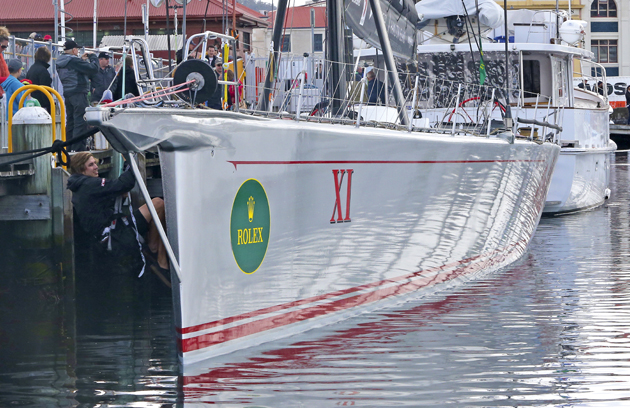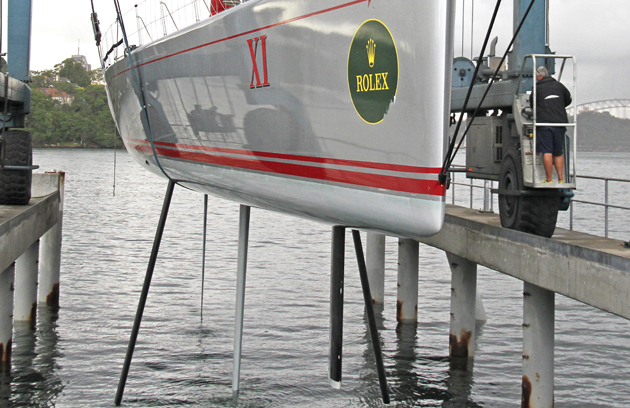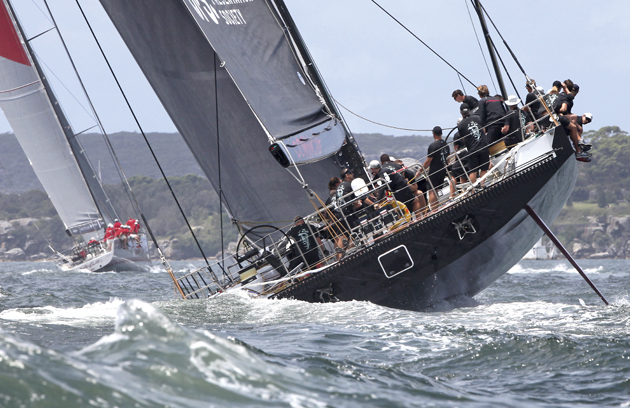Crosbie Lorimer takes a close look at Bob Oatley's Wild Oats XI, a nine-year-old that is still taking line honours around the world
Two themes recurred consistently in interviews with the skippers of the five super-maxis that raced the 2014 Rolex Sydney Hobart: good management and the right people. In both regards the core of the Wild Oats XI team has remained remarkably consistent over the decade since she was launched and the contribution that made to her record-breaking eighth win in 2014 should not be underestimated.
Apart from her crew of highly experienced and professional crew, who have raced aboard her for many years, Wild Oats is notable for the number of tweaks and reconfigurations she has had. A year earlier she had made the news after being nicknamed the Swiss Army Knife, following the addition of multiple foils. This year the mods were fewer, but no less significant. But the fact remains that for a nine-year-old boat to beat the brand new, no-holds-barred, master blaster Comanche was no mean feat.
But no amount of experience and expertise can make good a shortfall in boat speed. So what have been the major modifications necessary to keep Wild Oats XI on the pace?
Regular crewmember naval architect Steve Quigley cites five changes that have contributed most to Wild Oats XI’s winning ways over her nine-year lifespan.
The first was the removal of the forward rudder and the installation of the daggerboards, which made the boat more efficient downwind, but just as importantly improved lateral lift and VMG upwind. The daggerboards came with their own issues, however, the most problematic of which was the substantial shift in the centre of lateral resistance (CLR) which didn’t necessarily match the centre of effort (COE) under different sail configurations.
Small variations could be expected, but when changing from a jib to a Code 0 the COE on Wild Oats XI was moving forward by metres, producing lee helm in light airs.
To resolve this issue a forward centreboard was added – the second major modification – supplementing the twin daggerboards and stabilising the balance of the boat in the low wind ranges up to the point where boat speed matches wind speed, where the daggerboards take over again
The third refinement was the addition of a lateral foil (not a DSS, they say). Off the breeze in a seaway and strong winds Wild Oats XI had a tendency to bury the bow. The lateral foil provides lift and reduces that tendency, resulting in a more even downwind speed profile. A longer lateral foil was recently tested and shows further promise.
The fourth refinement was a new mast, 250kg lighter than its predecessor and substantially stiffer, with significant improvements in upwind speeds, especially in lighter airs. The stiffer mast gave the sail trimmers more options.
The final modification was the reshaping of the bow and rebuild of the bowsprit. The whole bow section was refaired to a narrower profile up to two metres abaft the stem and the bowsprit constructed to a more aerodynamic shape – the bobstay stem fitting was also lifted 500mm.
The result had additional benefits beyond streamlining. “The bow team . . . couldn’t believe how dry the boat now was,” says skipper Mark Richards.
As Wild Oats XI berthed in Hobart having achieved a record eight line honours wins in ten years, her owner Bob Oatley vowed to bring his boat back again next year. It is hard to know what further modifications can be effected. When quizzed on the subject after the race, helmsman Stuart Bannatyne smiled wryly, but was giving little away: “We’ve still got a few tricks up our sleeves!”
BOW The refairing of the bow section, remodelling of the bowsprit and lifting of the bobstay attachment to the stem have streamlined the forward end of the boat and made it drier for the bow team. Photographers are the only losers
LATERAL FOIL The lateral foil adds lift downwind, reducing any tendency to bury the bow into waves and thus improving the downwind speed profile. The foil is deployed to the windward side in upwind mode to minimise drag
FOILS From left to right: starboard daggerboard, rudder, keel, forward centreboard, port daggerboard. The aperture for the lateral foil can just be seen on the starboard side of the hull. Note original position of the bobstay
WITH COMANCHE Given that Wild Oats XI’s stern can fit twice into Comanche’s it’s hard to believe that the two boats were so evenly matched. But when Comanche heels at 25° she has the same wetted surface as Wild Oats. The latter’s narrower cross section allows her to gain mileage from VMG running
Specifications
LOA 30.48m/100ft 0in
Beam 5.10m/16ft 9in
Draught 5.91m/19ft 5in
Displacement 32,000kg/70,550lb
Ballast 14,000kg/30,864lb
Sail area: mainsail 382m2/4,112ft2
Jib 228m2/2,454ft2
Genoa 535m2/5,759ft2
Spinnaker 880m2/9,472ft2
IRC Rating 1.974
Designed by Reichel/Pugh
Built by McConaghy, launched December 2005
Hull type carbon/Nomex monohull
This is an extract from a feature in Yachting World March 2015 issue









